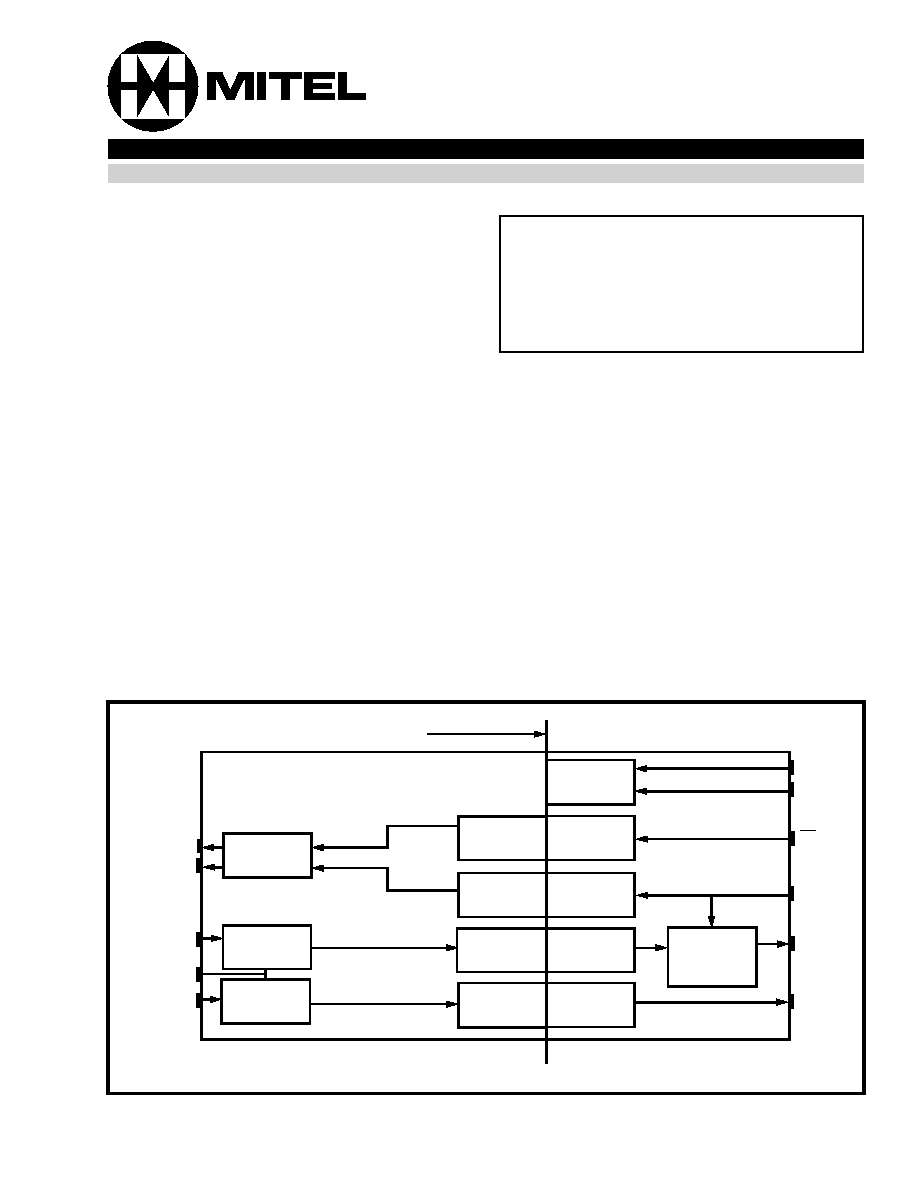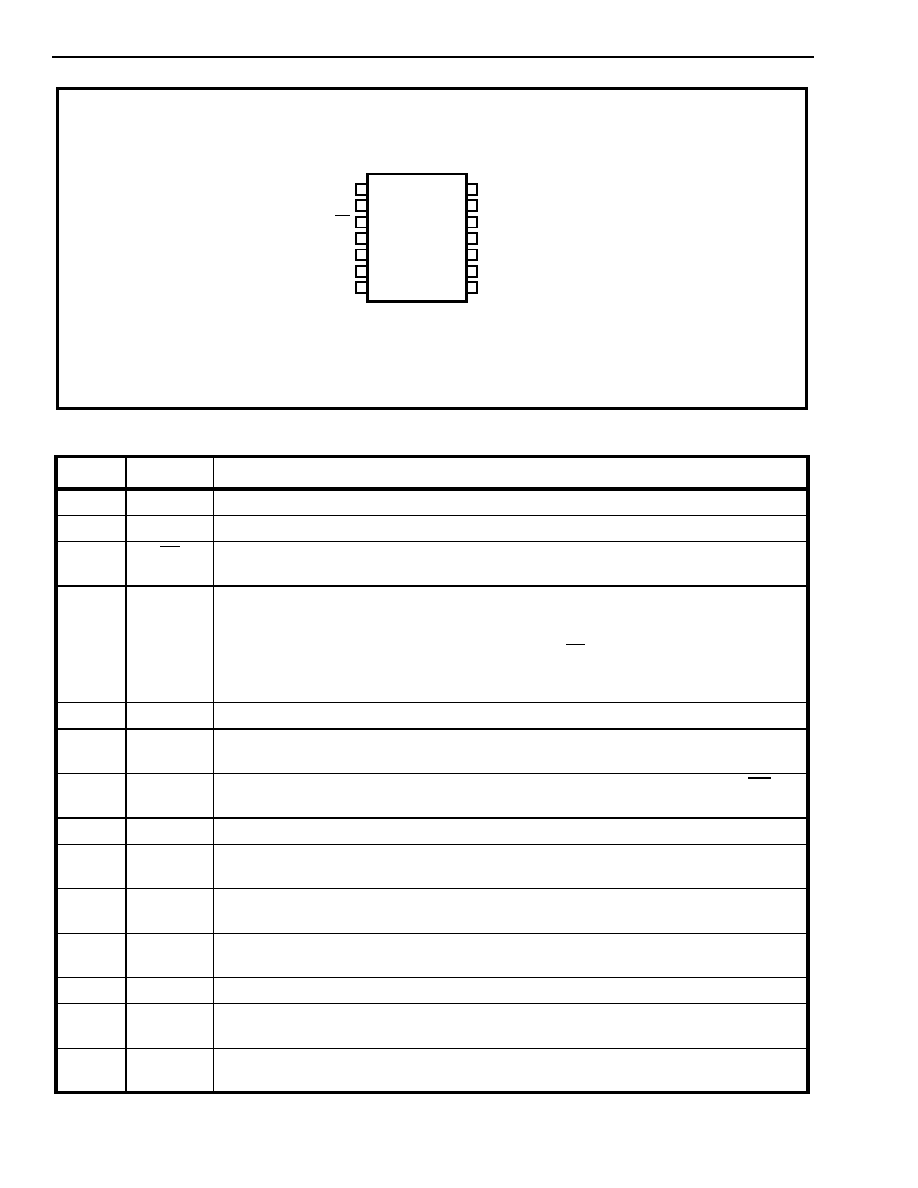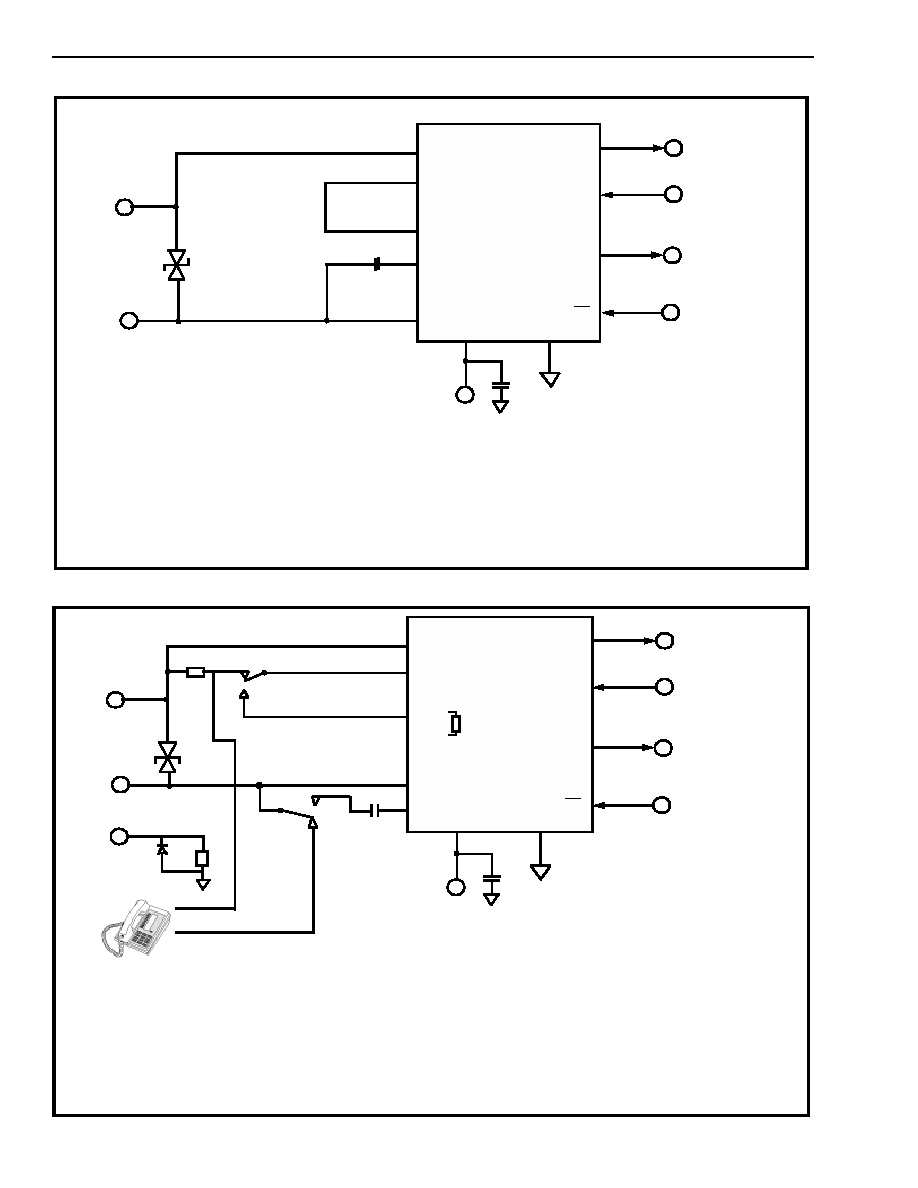 | –≠–ª–µ–∫—Ç—Ä–æ–Ω–Ω—ã–π –∫–æ–º–ø–æ–Ω–µ–Ω—Ç: MH88422 | –°–∫–∞—á–∞—Ç—å:  PDF PDF  ZIP ZIP |

2-21
Æ
Features
∑
FAX and Modem interface (V29/V22 bis)
∑
Variants match German, UK & 600
network
impedances
∑
Provides reinforced barrier to international PTT
requirements
∑
Transformerless 2-4 Wire conversion
∑
Loop start operation
∑
Pulse and DTMF operation
∑
Accommodates external monitor phone
∑
Line state detection outputs:
∑
-loop current/ringing outputs
∑
Single +5V operation, low idle power (5mW)
∑
Full Duplex
∑
Suitable for power down applications
Applications
Interface to Central Office for:
∑
DAA
∑
Modem
∑
FAX
∑
Answering Machine
∑
Terminal Equipment
Description
The Mitel MH88422 Line Interface Circuit provides a
complete audio and signalling link between audio
equipment and central office. The functions provided
by the MH88422 include 2-4 Wire conversion, loop
seizure, ring voltage and loop current detection. The
device is fabricated as thick film hybrid which
incorporates various technologies for optimum circuit
design, high voltage isolation and very high
reliability.
Variants are provided to meet German (-1) and UK
(-3) line impedance (see section on Line
Impedances), as well as a 600
variants (-2).
ISSUE
5
April 1995
Ordering Information
MH88422-1
14 Pin DIL Package
MH88422-2
14 Pin DIL Package
MH88422-3
14 Pin DIL Package
Surface Mount Options are available by adding the
Suffix "S"
Power
Supply
Opto-
Isolation
Logic Input
Buffer
Opto-
Isolation
Opto-
Isolation
Opto-
Isolation
Audio
Buffer
Audio
Buffer
Ring & Loop
Buffer
Transhybrid
Loss
Cancellation
Circuit
Active
Termination
Audio Input
Buffer
Input
Buffer
Isolation Barrier
VDD
AGND
LC
VR
VX
RVLC
TIP
RING
TXIN
TF
RLS
USER CONNECTIONS
NETWORK CONNECTIONS
Figure 1 - Functional Block Diagram
MH88422
Line Interface Circuit
Preliminary Information

2-22
MH88422
Preliminary Information
Figure 2 - Pin Connections
Pin Description
Pin #
Name
Description
1
VDD
Positive Power Supply Voltage. +5V.
2
AGND
Analog Ground. 4-Wire Ground. Normally connected to System Ground.
3
LC
Loop Control (Input). A logic low activates internal circuitry which provides a dc
termination across Tip and Ring. Used for seizing the line and dial pulsing.
4
RVLC
Ring Voltage and Current Detect (Output). A logic low indicates that loop current is
detected. The loop current can be due to the external monitor phone or the MH88422 in
the off-hook mode. The RVLC output pulses when the external monitor phone is dial
pulsing or when the MH88422 is dial pulsing via the LC input. In addition, when the
MH88422 is on the on-hook mode, a pulsing output indicates ringing voltage across the
Tip and Ring leads. The pulsing output frequency is twice the ringing frequency.
5
NC
No Connection should be made to this pin.
6
VX
Transmit (Output). 4-Wire ground (AGND) referenced audio output, biased at 2.5V.
Outputs in off-hook mode only.
7
VR
Receive (Input). 4-Wire ground (AGND) referenced audio input, biased at 2.5V. LC
must be activated low and loop current must be flowing.
8
NC
No Connection should be made to this pin.
9
RING
Ring Lead. Connects to the "Ring" lead of the central office through an optional relay
contact. The central office "Tip" and "Ring" leads may be interchanged.
10
TXIN
Transmit (Input). Connects to the "Ring" lead of the central office through a coupling
capacitor.
11
TF
Tip Feed. Connects to the "Tip" lead of the central office through an internal resistor and
an optional external resistor.
12
NC
No Connection should be made to this pin.
13
RLS
Ring Loop Sense (Input). Sense node for ringing voltage detector and the loop current
detector.
14
TIP
Tip Lead. Connects to the "Tip" lead of the central office through an optional relay
contact. The central office "Tip" and "Ring" leads may be interchanged.
RLS
NC
TF
TXIN
LC
NC
TIP
AGND
RING
RVLC
NC
VX
VR
VDD
1
2
3
4
5
6
7
8
9
10
11
12
13
14

Preliminary Information
MH88422
2-23
Functional Description
The MH88422 Line Interface Circuit is a COIC
(Central Office Interface Circuit) used to interface
FAX's Modems or user defined equipment to Central
Office 2-Wire Analog Trunks.
Opto-Isolation
The isolation barrier is designed to meet regulatory
requirements for a reinforced barrier of 3kVac. It
provides full isolation of mains voltages up to 250V
RMS and all telecom voltages.
In order that this barrier is not bypassed a creepage/
clearance distance of 6.4mm minimum must be
maintained between wiring, pcb tracking, etc.,
connected to external circuitry on either side of the
barrier. To make this requirement simpler, pins on the
MH88422 connected to opposite sides of the barrier
are on opposite sides of the package.
External Protection Circuit
To meet regulatory high voltage requirement, an
external protection circuit is required. The protection
circuit shown in Figure 3 (Clamp Diode D1) is
recommended.
DC Loop Termination
The DC loop termination circuitry provides the loop
with an active DC load termination when a logic low
is applied to the LC (Loop Control) input. The
termination is similar to a resistance of
approximately 300
(loop current dependent).
Internal optically isolated circuitry is used to switch
the termination in and out the loop. This is used for
both seizing the line as well as generating dial
pulses. The MH88422 will not seize the line when
powered down.
Supervision Features
The supervision circuitry is capable of detecting
ringing voltage and loop current as well as the status
of an optional external monitor phone. The RVLC
(Ring Voltage Loop Current Detect) output provides
a logic low when loop current flows due to the
external monitor phone or the MH88422 being in the
off-hook mode.
The RVLC outputs pulses when the external monitor
phone is dial pulsing or when the MH88422 is dial
pulsing via the LC mode.
In addition, when the MH88422 is on-hook, a pulsing
output indicates that ringing voltage is across the tip
and ring leads; the pulsing output frequency is twice
the ringing frequency. See Figure 3.
Ringing frequency may require external validation.
An RC monostable is usually satisfactory for this
purpose or this may also be achieved using software
applications.
2-4 Wire Conversion
The 2-4 Wire conversion circuit converts the
balanced full duplex signal at Tip and Ring of the
central office line into a transmit ground referenced
signal at VX (Transmit) of the MH88422. It also
converts the receive ground referenced signal at VR
(Receive) of the MH88422 into a balanced transmit
signal at Tip and Ring of the central office line.
In full duplex transmission, the Tip-Ring signal
consists of an audio signal from the central office as
well as an audio signal due to the VR input. There is
an internal cancellation circuit which prevents the V
R
signal appearing at the VX output. The degree to
which the 2-4 wire conversion circuit minimizes the
contribution of the VR signal at the VX output is
specified as transhybrid loss (THL).
The MH88422 is suitable to drive a COMBO II codec
or a VLSI modem device.
Line Impedance
The MH88422 provides a fixed Tip-ring impedance
which conforms to the following PTT requirements.
MH88422-1 Zin = 200 + 820 // 115nF
Germany
MH88422-2 Zin = 600
MH88422-3 Zin = 370 + 620 // 310nF
UK

2-24
MH88422
Preliminary Information
.
*
Exceeding these values may cause permanent damage. Functional operation under these conditions is not implied
Typical figures are at 25∞C with nominal +5V supply and are for design aid only
Loop Electrical Characteristics*
* Loop Electrical Characteristics are over recommended operating conditions unless otherwise stated.
Typical figures are at 25∞C and are for design aid only.
Note 1: All of the above characteristics use a test circuit as per Figure 3.
Absolute Maximum Ratings* -
All voltages are with respect to AGND unless otherwise specified.
Parameter
Symbol
Min
Max
Units
1
DC Supply Voltage
V
DD
-0.3
6
V
2
Storage Temperature
T
S
-55
+80
∞C
3
DC Loop Voltage
V
Bat
-100
+100
V
4
Ringing Voltage
V
R
-
120
V
RMS
5
Loop Current
I
Loop
-
90
mA
Recommended Operating Conditions
.
Parameters
Sym
Min
Typ
Max
Units
Test Conditions
1
DC Supply Voltages
V
DD
4.5
5.0
5.5
V
2
Operating Temperature
T
OP
0
70
∞C
3
Ringing Voltage
V
R
75
V
RMS
V
Bat
=-48V
Characteristics
Sym
Min
Typ
Max
Units
Test Conditions
1
Ringing Voltage No Detect
-1 Variant only Detect
VR
27
20
V
RMS
V
RMS
Refer to FT2 1TR2 for test
method
Ringing Voltage No Detect
All other Variants Detect
VR
14
7
V
RMS
V
RMS
Externally
Adjustable
2
Ringing Frequency
15
68
Hz
3
On-Hook 2-wire Impedance
40k
1kHz
4
Operating Loop Current
15
80
mA
5
Operating Loop Resistance
2800
V
Bat
=-48V, I
Loop
=15mA
6
Off-Hook DC -1 Variant
Voltage
-2 Variant
-3 Variant
6.0
6.0
4.0
4.0
6.0
6.0
9.6
15
6.0
7.8
9.0
12.5
V
V
V
V
V
V
I
Loop
=25mA
I
Loop
=42mA
I
Loop
=15-20mA
I
Loop
=26mA
I
Loop
=25mA
I
Loop
=42mA
7
Leakage Current (2-Wire to AGND)
10
µ
A
100V
DC
8
Leakage Current on Hook
(Tip to Ring)
9
10
µ
A
V
Bat
=-50V
9
DC Resistance during dialling
-1 variant only
200
220
I
Loop
=20-40mA
10
Dial Pulse Distortion ON
-1 Variant OFF
All other Variant
0
+6
0
+2
+8
+2
+4
+10
+4
ms
ms
ms

Preliminary Information
MH88422
2-25
DC Electrical Characteristics are over Recommended Operating Conditions unless otherwise stated.
Typical figures are at 25
∞
C with nominal+ 5V supplies and are for design aid only.
Electrical Characteristics are over Recommended Operating Conditions unless otherwise stated.
Typical figures are at 25
∞
C and are for design aid only.
Note 1: All of the above characteristics use a test circuit as per Figure 3.
Note 2: All of the above test conditions use a test source impedance which matches the device's impedance.
Note 3: dBm is referenced to 600
unless otherwise stated
.
DC Electrical Characteristics
Characteristics
Sym
Min
Typ
Max
Units
Test Conditions
1
RVLC
LC
Supply Current
I
DD
3
mA
V
DD
= -5.0V, Idle state
2
Power Consumption
PC
15
mW
V
DD
= -5.0V, Idle state
3
Low Level Output Voltage
High Level Output Voltage
V
OL
V
OH
2.4
0.4
V
V
I
OL
= 4mA
I
OH
= 0.4mA
4
Low Level Input Voltage
High Level Input Voltage
Low Level Input Current
High Level Input Current
V
IL
V
IH
I
IH
I
IL
2.0
0.8
60
60
V
V
µ
µ
A
V
IH
= 5.0V
V
IL
= 0.0V
5
AC Electrical Characteristics
- MH88422 All Variants
Characteristics
Sym
Min
Typ
Max
Units
Test Conditions
1
Input Impedance VR
47k
2
Output Impedance at VX
10
3
Receive Gain (VR to 2-wire)
Frequency Response Gain
(relative to Gain @ 1kHz)
3.5
dB
Input 0.5V at 1kHz
4
0
0
dB
dB
300 Hz
3400 Hz
5
Signal Output Overload Level
at 2-Wire
at VX
THD <5% @ 1kHz
I
Loop
=15 to 40mA
+2.0
+3.0
dBm
V
DD
=4.5V to 5.5V
+2.0
+3.0
dBm
6
Total Harmonic Distortion
at 2-wire
at VX
THD
1.2
1.2
%
%
Input -10dB at 1kHz
DC loop = 25mA
V
DD
=5.0V
7
Power Supply Reject Ratio
at 2-wire
at VX
PSRR
30
30
dB
dB
Ripple 0.1V,1kHz on
V
DD
8
Transhybrid Loss
THL
20
dB
Input -3.5dBm, 1kHz at
V
R

2-26
MH88422
Preliminary Information
Electrical Characteristics are over Recommended Operating Conditions unless otherwise stated.
Typical figures are at 25
∞
C and are for design aid only.
AC Electrical Characteristics
- MH88422-2
Electrical Characteristics are over Recommended Operating Conditions unless otherwise stated.
Typical figures are at 25
∞
C and are for design aid only.
AC Electrical Characteristics
- MH88422-1
Characteristics
Sym
Min
Typ
Max
Units
Test Conditions
1
2-Wire input Impedance
(200
+ 820
//115nF)
Zin
900
@ 1kHz
2
Return Loss at 2-Wire
(200
+ 820
//115nF)
RL
20
20
20
22
24
26
dB
dB
dB
300-500Hz
500-2500Hz
2500-3400Hz
3
Longitudinal to Metallic Balance
40
55
53
65
60
60
dB
dB
dB
50-300Hz
300-1000Hz
1000-4000Hz
4
Idle Channel Noise
at 2-Wire
At VX
Nc
-72
-72
-58
dBmp
dBmp
5
Transmit Gain (2-Wire to VX)
-0.4
dB
Input 0.5V @ 1kHz
Off -Hook
6
Frequency Response Gain
(relative to gain @ 1kHz)
-0.6
-0.6
dB
dB
300Hz
3400Hz
Characteristics
Sym
Min
Typ
Max
Units
Test Conditions
1
2-Wire Input Impedance
(600
)
ZIn
600
@ 1kHz
2
Return Loss at 2-Wire
(Reference 600
)
ERL
SFRL
20
14
20
18
dB
500-2500Hz
200-3200Hz
3
Longitudinal to Metallic Balance
Metallic to Longitudinal Balance
58
53
60
40
60
55
dB
dB
dB
dB
200-1000Hz
1k-3kHz
200-1000Hz
1k-4kHz
4
Idle Channel Noise
at 2-Wire
at VX
Nc
13
13
20
dBrnC
dBrnC
5
Transmit Gain (2-Wire to Vx)
-0.4
dB
Input 0.5V @ 1kHz
Off- Hook
6
Frequency Response Gain
(relative to gain @ 1kHz)
-0.6
-0.6
dB
dB
200Hz
3400Hz

2-27
Preliminary Information
MH89770
AC Electrical Characteristics
- MH88422-3
AC Electrical Characteristics are over Recommended Operating Conditions unless otherwise stated.
Typical figures are at 25
∞
C and are for design aid only.
Note 1: All of the above characteristics use a test circuit as per Figure 3.
Note 2: All of the above test conditions use a test source impedance which matches the device's impedance.
Note 3: dBm is referenced to 600
unless otherwise stated
.
Characteristics
Sym
Min
Typ
Max
Units
Test Conditions
1
2-Wire Input Impedance
(370
+ 620
// 310nF)
Zin
700
@ 1kHz
2
Return Loss at 2-Wire
(370
+ 620
// 310nF)
RL
18
20
dB
200-2400Hz
3
Longitudinal to Metallic Balance
50
60
dB
300-3400Hz
4
Idle Channel Noise
at 2-Wire
at VX
Nc
-80
-80
-70
-68
dBmp
dBmp
5
Transmit Gain (2-Wire to Vx)
-0.4
dB
Input 0.5V @ 1kHz
Off-Hook
6
Frequency Gain
(relative to gain @ 1kHz)
-0.6
-0.6
dB
dB
300Hz
3400Hz
TIP-RING Drive Circuit
The audio input ground (AGND) referenced signal at
VR, biased at 2.5V, is converted to a balanced output
signal at Tip-Ring. 2-4 wire isolation is achieved
through the use of optocouplers when the LC input is
activated, low, and loop current flowing.
TIP-RING Receive Circuit
The differential audio signal at Tip-Ring is converted to
a ground (AGND) referenced signal, biased at 2.5V, at
the VX output. 2-4 Wire isolation is achieved through
the use of optocouplers. The receive circuit operated
when LC is low and loop current is flowing
Transmit Gain
Transmit Gain (Tip-Ring to VX) is fixed as indicated in
"AC Electrical Characteristics".
However, by adding external resistors to the VX
output, the Transmit Gain can be reduced as shown in
Figure 5. To limit the output current drawn, the
minimum recommended resistance to ground is 2k
.
Overall Transmit Gain =
-0.4 dB + 20log (R4 / (R4 + R3))
The output impedance of the VX output is about 10
,
therefore, with two external 1k
resistors configured
as per Figure 5, this will result in 6dB of attenuation for
a total gain of -6.4dB. For correct gain, the MH88422
input impedance must match the line impedance.
Receive Gain
Receive Gain (VR to Tip-Ring) is fixed as indicated in
"AC Electrical Characteristics". However, by adding a
single external resistor in series with the VR input,
the Receive Gain can be reduced.
Overall Receive Gain =
3.5dB + 20log (47k
/(47k
+ Rext),
The input impedance of the VR input is 47k
,
therefore, an external 100k
resistor in series with
this input will result in 10dB of attenuation for a total
gain of -6.5dB.
For correct gain, the MH88422 input impedance
must match the line impedance.

2-28
MH88422
Preliminary Information
Figure 3 - Typical Application Circuit
Figure 4 - Typical Application Circuit with Dummy Ringer and Monitor Phone
TIP
RLS
TF
TXIN
RING
VX
VR
RVLC
LC
AGND
VDD
TIP
RING
C2
C1
+5V
1
2
3
4
6
7
9
10
11
13
14
D1
Audio Output
Audio Input
Ring Voltage & Loop
Current Detect Output
Loop Control Input
MH88422
NOTES:
Calls are set up and cleared in this mode by the
external controller. It turns on the loop via Loop
Control, dialling by pulsing loop control (or via
DTMF tones) and clearing down by turning Loop
Control off.
1) C1: 10
µ
F, 6V Tantalum
2) C2: 0.1
µ
F, 250V (Typical Value)
3) D1: 180VDC Foldback Diode, e.g. TISP4180, TISP5180
4) VX and VR are biased at 2.5V, therefore, coupling capacitors
may be required depending on application.
+
TIP
RLS
TF
TXIN
RING
VX
VR
RVLC
LC
AGND
VDD
TIP
RING
C2
C1
+5V
1
2
3
4
6
7
9
10
11
13
14
D1
Audio Output
Audio Input
Ring Voltage & Loop
Current Detect Output
Loop Control Input
MH88422
NOTES
:
1) C1: 10
µ
F, 6V Tantalum
2) C2: 0.47
µ
F, 100V
3) D1: 180VDC Foldback Diode, e.g. TISP4180, TISP5180
4) VX and VR are biased at 2.5V, therefore, coupling capacitors
may be required depending on application.
+
R2 & C2 form a dummy ringer, where R2 is on the hybrid and C2 must be fitted by the customer.
To initate a manual call, lift the handset. The RVLC pin will indicate that the line has been seized by the monitor phone.
The required number is then dialled and the connections established. During this phase the Loop Control
input should be turned ON to ensure that when the relay K1 is operated and the monitor phone removed from the line loop
current is still maintained. On receipt of the correct progress tones the external controller should control the data transmission
and clear down the call when it is completed by turning the Loop Control OFF. For applications in some countries such as
Germany the MH88422 can not be used with an optional telephone but may still be used in a combined telephone/fax machine.
K1b
K1a
Line
Relay
Input
K1
Internal
dummy
Ringer
Resistor
R2
K1b
5) R6 adjust the monitor phone detect sensitivity typically set to 200 ohms for 5mA limit on the
-1 variant and 75 ohms on the -3 variant.
6) K1b is added to remove the dummy ringer when using a combined phone on the-1 variant
and is not required for all other variants.
R6

Preliminary Information
MH88422
2-29
Figure 5 - Typical Application Circuit for Gain Adjustment
Figure 6 - Typical Application Circuit with Meter Pulse Filter and Coupling Capacitor
TIP
RLS
TF
TXIN
RING
VX
VR
RVLC
LC
AGND
VDD
TIP
RING
C2
C1
+5V
1
2
3
4
6
7
9
10
11
13
14
D1
Audio Output
Audio Input
Ring Voltage & Loop
Current Detect Output
Loop Control Input
MH88422
1) C1: 10
µ
F, 6V Tantalum
2) C2: 0.1
µ
F, 250V (Typical Value)
3) D1:
180VDC Foldback Diode, e.g. TISP4180, TISP5180
4) VX and VR are biased at 2.5V, therefore, coupling capacitors
may be required depending on application.
+
RECEIVE GAIN:
Audio input to Tip-Ring
=20log(47k/(R5+47K))+3.5dB
= -6.5dB
TRANSMIT GAIN:
Tip-Ring to Audio Output
=20log(R4(R3+R4))-0.4dB
= -6.4dB
Note:
The VX output gain has been reduced by 6dB
(to -6.4dB) and the VR input gain has been
reduced by 9.9dB (to -6.4dB) in this example.
5) (R3+R4) should be > 2k
to prevent overload.
R3
100k
R4
R5
TIP
RLS
TF
TXIN
RING
VX
VR
RVLC
LC
AGND
VDD
TIP
RING
C2
C1
+5V
1
2
3
4
6
7
9
10
11
13
14
D1
MH88422
1) C1: 10
µ
F, 6V Tantalum
2) C2: 0.1
µ
F, 250V (Typical Value)
3) D1:180VDC Foldback Diode,
+
Note:
Meter pulses at high frequency (16kHz or 12kHz) and high level (10V RMS) are used in some countries.
The VX amplifier has a low pass filter which attenuates by typically 15dB at 16kHz (For the -1 variant).
If this proves insufficient for specific applications, an LC reject filter is recommended.
e.g. TISP4180, TISP5180.
Meter
Pulse
Detector
Meter
Pulse
Filter
10
µ
F
10
µ
F
Loop Control Input
Current Detect Output
Ring Voltage & Loop
Audio Input
Audio Output

2-30
MH88422
Preliminary Information
Figure 7 -Typical Application Circuit showing UK Dummy Ringer Circuit.
Figure 8 - Mechanical Data for 14 Pin DIL Hybrid
TIP
RLS
TF
TXIN
RING
VX
VR
RVLC
LC
AGND
VDD
TIP
RING
C2
C1
+5V
1
2
3
4
6
7
9
10
11
13
14
D1
MH88422
1) C1: 10
µ
F, 6V Tantalum
2) C2:1.8
µ
F, 250V (Normally in master socket)
3) D1:180VDC Foldback Diode, e.g. TISP4180, TISP5180
+
R2
Notes:
Loop Control Input
Current Detect Output
Ring Voltage & Loop
Audio Input
Audio Output
1.42 Max
(36.1 Max)
0.19 Max (4.8 Max)
0.10 Typ
(2.54 Typ)
0.020 + 0.005
(0.5 + 0.12)
0.063 Max(1.6 Min)
0.26+0.015 (6.6+0.4)
AAAA
AAAA
AAAA
AAAA
AAAA
AAAA
AAAA
AAAA
AAAA
AAAA
AAAA
AAAA
AAAA
AAAA
AAAA
AAAA
AAAA
AAAA
AAAA
AAAA
AAA
AAA
AAA
AAA
AAAA
AAAA
AAAA
AAAA
AAAA
AAAA
AAAA
AAAA
AAAA
AAAA
AAAA
AAAA
AAAA
AAAA
AAAA
AAAA
AAAA
AAAA
AAAA
AAAA
AAAA
AAAA
AAAA
AAAA
AAAA
AAA
AAA
AAA
AAA
AAA
(22.9 Typ)
0.95 Max
(24.2 Max)
0.90 Typ
0.27 Max
(6.9 Max)
0.08 Typ (2 Typ)
0.200+0.010
(5.08+0.25)
*
1
Notes:
1) Not to scale
2) Dimensions in inches).
3) (Dimensions in millimetres).
*Dimensions to centre of pin.

Preliminary Information
MH88422
2-31
Figure 9 - Mechanical Data for 14 Pin Surface Mount Hybrid
Figure 10 - Recommended Footprint for 14 Pin Surface Mount Hybrid
AAAA
AAAA
AAAA
AAAA
AAAA
AAAA
AAAA
AAAA
AAAA
AAAA
AAAA
AAAA
AAAA
AAAA
AAAA
AAAA
AAAA
AAAA
AAAA
AAAA
AAA
AAA
AAA
AAA
1.08 Max
(27.4 Max)
0.20 + 0.005
(5.0 + 0.12)
1.42 Max
(36.1 Max)
0.19 Max
(4.8 Max)
0.063 Max
(1.6 Max)
0.33 Max
(8.4 Max)
AAAA
AAAA
AAAA
AAAA
AAAA
AAAA
AAAA
AAAA
AAAA
AAAA
AAAA
AAAA
AAAA
AAAA
AAAA
AAAA
AAAA
AAAA
AAAA
AAAA
AAA
AAA
AAA
AAA
0.125+0.015±
(3.18+0.38)
0.060 Typ
(1.52)
0.10 Typ
(2.54 Typ)
*
*
0.20 + 0.010
(5.08 + 0.25)
0.08 Typ (2 Typ)
AAAA
AAAA
AAAA
AAAA
AAAA
AAAA
AAAA
AAAA
AAAA
AAAA
AAAA
AA
AA
AA
AA
AA
AA
AA
AA
AA
AA
AA
Notes:
1) Not to scale
2) Dimensions in inches).
3) (Dimensions in millimetres).
*Dimensions to centre of pin.
0.1
(2.5)
0.89
(22.6)
0.04
(1.02)
0.16
(4.06)

2-32
MH88422
Preliminary Information
Notes:











